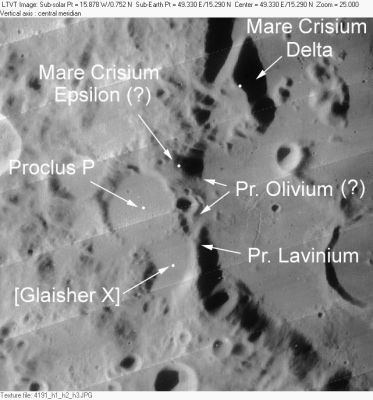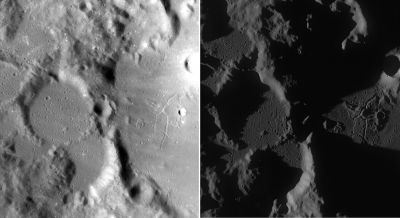Promontorium Olivium
Contents
Promontorium Olivium
(discontinued(?) IAU name)
|
Lat: 15.5°N, Long: 49.3°E, Diameter: km, Depth: km, Rukl: 26 | |
Right: Two LROC views (WAC No.'s M119530553ME and M117169050ME) of the region under different lighting conditions. Both images calibrated by LROC_WAC_Previewer.
Images
LPOD Photo Gallery Lunar Orbiter Images
Maps
(LAC zone 61B2) LAC map Geologic map LTO map
Description
Bounding the tiny break in the western rim of the Crisium Basin are two headlands that almost meet. To the north is the area east of the crater Proclus P, and to the south is the eastern wall of Glaisher X. Each of these headlands was named in the late 1800s by the English selenographer William Birt. He called the northern one Promontorium Olivium and the southern Promontorium Lavinium. Both of these names were included in Named Lunar Formations and in the System of Lunar Craters, but do not appear in the current list of IAU names. Prom. Olivium is broad and flatly rounded in cross-section, it appears to be the continuation of the Crisium Basin rim. Prom. Lavinium is narrower with a more V-shaped profile - it cast the more dramatic shadow under low illumination. These are conspicuous landmarks and these names should be re-instated.
Additional Information
- The southwestern slopes of the peak in Promontorium Olivium formerly known as Mare Crisium Epsilon has an odd terraced structure -- like fish scales -- visible in the Lunar Orbiter photo when viewed at higher magnification.
- Promontorium Olivium is the site of the somewhat infamous O'Neill's Bridge.
Nomenclature
- The name Promontorium Olivium, as well as the names Mare Crisium Delta and Mare Crisium Epsilon, appeared both in the Collated List (1913) and in Named Lunar Formations (1935, where Prom. Olivium was Catalog #99). The coordinates given for Prom. Olivium are extremely close to those for Promontorium Lavinium, suggesting the name referred just to the thin cratered southern tip of the northern headland. The position given forMare Crisium Epsilon corresponded more closely to the main peak, as illustrated by the labels on the Lunar Orbiter image reproduced above. On maps A3 and A4 of the System of Lunar Craters, the names Mare Crisium Delta and Mare Crisium Epsilon were dropped and the outline of Promontorium Olivium was extended up to include that area. However neither Prom. Olivium nor Promontorium Lavinium were labeled on the contemporaneous LAC maps (although Mare Crisium Delta was). Promontorium Olivium does not appear in later lists of IAU-approved nomenclature; yet it also does not appear on any published list of deletions, and the name does not appear to have ever been formally dropped.
LPOD Articles
Sunset on the Wasatch Mountains
Bibliography

